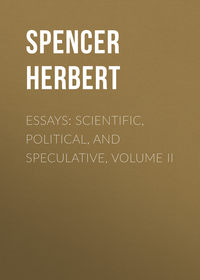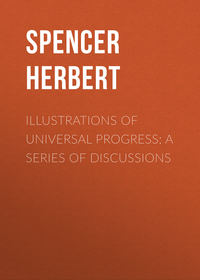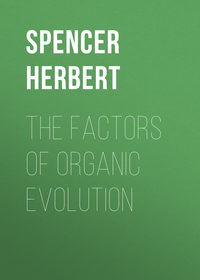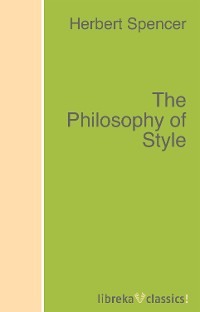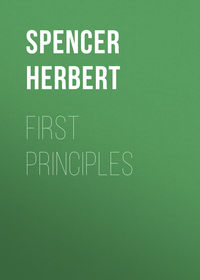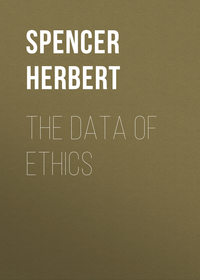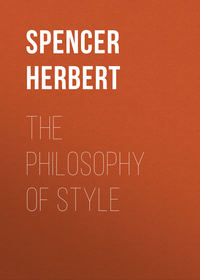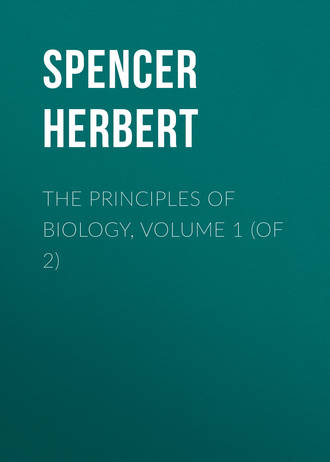 полная версия
полная версияThe Principles of Biology, Volume 1 (of 2)
While the evidence usually supposed to prove progression is thus untrustworthy, there is trustworthy evidence that there has been, in many cases, little or no progression. Though the orders which have existed from palæozoic and mesozoic times down to the present day, are almost universally changed, yet a comparison of ancient and modern members of these orders shows that the total amount of change is not relatively great, and that it is not manifestly towards a higher organization. Though nearly all the living forms which have prototypes in early formations differ from these prototypes specially, and in most cases generically, yet ordinal peculiarities are, in numerous cases, maintained from the earliest times geologically recorded, down to our own time; and we have no visible evidence of superiority in the existing genera of these orders. In his lecture "On the Persistent Types of Animal Life," Prof. Huxley enumerated many cases. On the authority of Dr. Hooker he stated "that there are Carboniferous plants which appear to be generically identical with some now living: that the cone of the Oolitic Araucaria is hardly distinguishable from that of an existing species; that a true Pinus appears in the Purbecks and a Juglans in the chalk." Among animals he named palæozoic and mesozoic corals which are very like certain extant corals; genera of Silurian molluscs that answer to existing genera; insects and arachnids in the coal-formations that are not more than generically distinct from some of our own insects and arachnids. He instanced "the Devonian and Carboniferous Pleuracanthus, which differs no more from existing sharks than these do from one another;" early mesozoic reptiles "identical in the essential characters of their organization with those now living;" and Triassic mammals which did not differ "nearly so much from some of those which now live, as these differ from one another." Continuing the argument in his "Anniversary Address to the Geological Society" in 1862, Prof. Huxley gave many cases in which the changes that have taken place, are not changes towards a more specialized or higher organization – asking "in what sense are the Liassic Chelonia inferior to those which now exist? How are the Cretaceous Ichthyosauria, Plesiosauria, or Pterosauria less embryonic or more differentiated species than those of the Lias?" While, however, contending that in most instances "positive evidence fails to demonstrate any sort of progressive modification towards a less embryonic or less generalized type in a great many groups of animals of long-continued geological existence," Prof. Huxley added that there are other groups, "co-existing with them under the same conditions, in which more or less distinct indications of such a process seem to be traceable." And in illustration of this, he named that better development of the vertebræ which characterizes some of the more modern fishes and reptiles, when compared with ancient fishes and reptiles of the same orders; and the "regularity and evenness of the dentition of the Anoplotherium as contrasting with that of existing Artiodactyles."44
The facts thus summed up do not show that higher forms have not arisen in the course of geologic time, any more than the facts commonly cited prove that higher forms have arisen; nor are they regarded by Professor Huxley as showing this. Were those which have survived from palæozoic and mesozoic days down to our own day, the only types; and did the modifications, rarely of more than generic value, which these types have undergone, give no better evidences of increased complexity than are actually given by them; then it would be inferable that there has been no appreciable advance. But there now exist, and have existed during the more recent geologic epochs, various types which are not known to have existed in earlier epochs – some of them widely unlike these persistent types and some of them nearly allied to these persistent types. As yet, we know nothing about the origins of these new types. But it is possible that causes like those which have produced generic differences in the persistent types, have, in some or many cases, produced modifications great enough to constitute ordinal differences. If structural contrasts not exceeding certain moderate limits are held to mark only generic distinctions; and if organisms displaying larger contrasts are regarded as ordinally or typically distinct; it is obvious that the persistence of a given type through a long geologic period without apparently undergoing deviations of more than generic value, by no means disproves the occurrence of far greater deviations in other cases; since the forms resulting from such far greater deviations, being regarded as typically distinct forms, will not be taken as evidence of great change in an original type. That which Prof. Huxley's argument proves, and that only which he considers it to prove, is that organisms have no innate tendencies to assume higher forms; and that "any admissible hypothesis of progressive modification, must be compatible with persistence without progression through indefinite periods."
One very significant fact must be added concerning the relation between distribution in Time and distribution in Space. I quote it from Mr. Darwin: – "Mr. Clift many years ago showed that the fossil mammals from the Australian caves were closely allied to the living marsupials of that continent. In South America a similar relationship is manifest, even to an uneducated eye, in the gigantic pieces of armour like those of the armadillo, found in several parts of La Plata; and Professor Owen has shown in the most striking manner that most of the fossil mammals, buried there in such numbers, are related to the South American types. This relationship is even more clearly seen in the wonderland collection of fossil bones made by MM. Lund and Clausen in the caves of Brazil. I was so much impressed with these facts that I strongly insisted, in 1839 and 1845, on this 'law of the succession of types,' – on 'this wonderful relationship in the same continent between the dead and the living.' Professor Owen has subsequently extended the same generalization to the Mammals of the Old World. We see the same law in this author's restorations of the extinct and gigantic birds of New Zealand. We see it also in the birds of the caves of Brazil. Mr. Woodward has shown that the same law holds good with sea-shells, but from the wide distribution of most genera of molluscs, it is not well displayed by them. Other cases could be added, as the relation between the extinct and living landshells of Madeira, and between the extinct and living brackish-water shells of the Aralo-Caspian Sea."
The general results, then, are these. Our knowledge of distribution in Time, being derived wholly from the evidence afforded by fossils, is limited to that geologic time of which some records remain – cannot extend to those remoter times the records of which have been obliterated. From these remaining records, which probably form but a small fraction of the whole, the general facts deducible are these: – That such organic types as have lived through successive epochs, have almost universally undergone modifications of specific and generic values – modifications which have commonly been great in proportion as the period has been long. That besides the types which have persisted from ancient eras down to our own era, other types have from time to time made their appearance in the ascending series of strata – types of which some are lower and some higher than the types previously recorded; but whence these new types came, and whether any of them arose by divergence from the previously-recorded types, the evidence does not yet enable us to say. That in the course of long geologic epochs nearly all species, most genera, and a few orders, have become extinct; and that a species, genus, or order, which has once disappeared from the Earth never reappears. And, lastly, that the Fauna now occupying each separate area of the Earth's surface is very nearly allied to the Fauna which existed on that area during recent geologic times.
§ 108. Omitting sundry minor generalizations, the exposition of which would involve too much detail, what is to be said of these major generalizations?
The distribution in Space cannot be said to imply that organisms have been designed for their particular habitats and placed in them; since, besides the habitat in which each kind of organism is found there are commonly other habitats, as good or better for it, from which it is absent – habitats to which it is so much better fitted than organisms now occupying them, that it extrudes these organisms when allowed the opportunity. Neither can we suppose that the purpose has been to establish varieties of Floras and Faunas; since, if so, why are the Floras and Faunas but little divergent in widely-sundered areas between which migration is possible, while they are markedly divergent in adjacent areas between which migration is impossible?
Passing to distributions in Time, there arise the questions – why during nearly the whole of that vast period geologically recorded have there existed none of those highest organic forms which have now overrun the Earth? – how is it that we find no traces of a creature endowed with large capacities for knowledge and happiness? The answer that the Earth was not, in remote times, a fit habitation for such a creature, besides being unwarranted by the evidence, suggests the equally awkward question – why during untold millions of years did the Earth remain fit only for inferior creatures? What, again, is the meaning of extinction of types? To conclude that the saurian type was replaced by other types at the beginning of the tertiary period, because it was not adapted to the conditions which then arose, is to conclude that it could not be modified into fitness for the conditions; and this conclusion is at variance with the hypothesis that creative skill is shown in the multiform adaptations of one type to many ends.
What interpretations may rationally be put on these and other general facts of distribution in Space and Time, will be seen in the next division of this work.
PART III.
THE EVOLUTION OF LIFE
CHAPTER I.
PRELIMINARY
§ 109. In the foregoing Part, we have contemplated the most important of the generalizations to which biologists have been led by observation of organisms; as well as some others which contemplation of the facts has suggested to me. These Inductions of Biology have also been severally glanced at on their deductive sides; for the purpose of noting the harmony existing between them and those primordial truths set forth in First Principles. Having thus studied the leading phenomena of life separately, we are prepared for studying them as an aggregate, with the view of arriving at the most general interpretation of them.
There is an ensemble of vital phenomena presented by each organism in the course of its growth, development, and decay; and there is an ensemble of vital phenomena presented by the organic world as a whole. Neither of these can be properly dealt with apart from the other. But the last of them may be separately treated more conveniently than the first. What interpretation we put on the facts of structure and function in each living body, depends entirely on our conception of the mode in which living bodies in general have originated. To form some conclusion respecting this mode – a provisional if not a permanent conclusion – must therefore be our first step.
We have to choose between two hypotheses – the hypothesis of Special Creation and the hypothesis of Evolution. Either the multitudinous kinds of organisms which now exist, and the far more multitudinous kinds which have existed during past geologic eras, have been from time to time separately made; or they have arisen by insensible steps, through actions such as we see habitually going on. Both hypotheses imply a Cause. The last, certainly as much as the first, recognizes this Cause as inscrutable. The point at issue is, how this inscrutable Cause has worked in the production of living forms. This point, if it is to be decided at all, is to be decided only by examination of evidence. Let us inquire which of these antagonist hypotheses is most congruous with established facts.
CHAPTER II.
GENERAL ASPECTS OF THE SPECIAL-CREATION-HYPOTHESIS.45
§ 110. Early ideas are not usually true ideas. Undeveloped intellect, be it that of an individual or that of the race, forms conclusions which require to be revised and re-revised, before they reach a tolerable correspondence with realities. Were it otherwise there would be no discovery, no increase of intelligence. What we call the progress of knowledge, is the bringing of Thoughts into harmony with Things; and it implies that the first Thoughts are either wholly out of harmony with Things, or in very incomplete harmony with them.
If illustrations be needed the history of every science furnishes them. The primitive notions of mankind as to the structure of the heavens were wrong; and the notions which replaced them were successively less wrong. The original belief respecting the form of the Earth was wrong; and this wrong belief survived through the first civilizations. The earliest ideas that have come down to us concerning the natures of the elements were wrong; and only in quite recent times has the composition of matter in its various forms been better understood. The interpretations of mechanical facts, of meteorological facts, of physiological facts, were at first wrong. In all these cases men set out with beliefs which, if not absolutely false, contained but small amounts of truth disguised by immense amounts of error.
Hence the hypothesis that living beings resulted from special creations, being a primitive hypothesis, is probably an untrue hypothesis. It would be strange if, while early men failed to reach the truth in so many cases where it is comparatively conspicuous, they reached it in a case where it is comparatively hidden.
§ 111. Besides the improbability given to the belief in special creations, by its association with mistaken beliefs in general, a further improbability is given to it by its association with a special class of mistaken beliefs. It belongs to a family of beliefs which have one after another been destroyed by advancing knowledge; and is, indeed, almost the only member of the family surviving among educated people.
We all know that the savage thinks of each striking phenomenon, or group of phenomena, as caused by some separate personal agent; that out of this conception there grows up a polytheistic conception, in which these minor personalities are variously generalized into deities presiding over different divisions of nature; and that these are eventually further generalized. This progressive consolidation of causal agencies may be traced in the creeds of all races, and is far from complete in the creed of the most advanced races. The unlettered rustics who till our fields, do not let the consciousness of a supreme power wholly absorb the aboriginal conceptions of good and evil spirits, and of charms or secret potencies dwelling in particular objects. The earliest mode of thinking changes only as fast as the constant relations among phenomena are established. Scarcely less familiar is the truth, that while accumulating knowledge makes these conceptions of personal causal agents gradually more vague, as it merges them into general causes, it also destroys the habit of thinking of them as working after the methods of personal agents. We do not now, like Kepler, assume guiding spirits to keep the planets in their orbits. It is no longer the universal belief that the sea was once for all mechanically parted from the dry land; or that the mountains were placed where we see them by a sudden creative act. All but a narrow class have ceased to suppose sunshine and storm to be sent in some arbitrary succession. The majority of educated people have given up thinking of epidemics of punishments inflicted by an angry deity. Nor do even the common people regard a madman as one possessed by a demon. That is to say, we everywhere see fading away the anthropomorphic conception of Cause. In one case after another, is abandoned the ascription of phenomena to a will analogous to the human will, working by methods analogous to human methods.
If, then, of this once-numerous family of beliefs the immense majority have become extinct, we may not unreasonably expect that the few remaining members of the family will become extinct. One of these is the belief we are here considering – the belief that each species of organism was specially created. Many who in all else have abandoned the aboriginal theory of things, still hold this remnant of the aboriginal theory. Ask any well-informed man whether he accepts the cosmogony of the Indians, or the Greeks, or the Hebrews, and he will regard the question as next to an insult. Yet one element common to these cosmogonies he very likely retains: not bearing in mind its origin. For whence did he get the doctrine of special creations? Catechise him, and he is forced to confess that it was put into his mind in childhood, as one portion of a story which, as a whole, he has long since rejected. Why this fragment is likely to be right while all the rest is wrong, he is unable to say. May we not then expect that the relinquishment of all other parts of this story, will by and by be followed by the relinquishment of this remaining part of it?
§ 112. The belief which we find thus questionable, both as being a primitive belief and as being a belief belonging to an almost-extinct family, is a belief not countenanced by a single fact. No one ever saw a special creation; no one ever found proof of an indirect kind that a special creation had taken place. It is significant, as Dr. Hooker remarks, that naturalists who suppose new species to be miraculously originated, habitually suppose the origination to occur in some region remote from human observation. Wherever the order of organic nature is exposed to the view of zoologists and botanists, it expels this conception; and the conception survives only in connexion with imagined places, where the order of organic nature is unknown.
Besides being absolutely without evidence to give it external support, this hypothesis of special creations cannot support itself internally – cannot be framed into a coherent thought. It is one of those illegitimate symbolic conceptions which are mistaken for legitimate symbolic conceptions (First Principles, § 9), because they remain untested. Immediately an attempt is made to elaborate the idea into anything like a definite shape, it proves to be a pseud-idea, admitting of no definite shape. Is it supposed that a new organism, when specially created, is created out of nothing? If so, there is a supposed creation of matter; and the creation of matter is inconceivable – implies the establishment of a relation in thought between nothing and something – a relation of which one term is absent – an impossible relation. Is it supposed that the matter of which the new organism consists is not created for the occasion, but is taken out of its pre-existing forms and arranged into a new form? If so, we are met by the question – how is the re-arrangement effected? Of the myriad atoms going to the composition of the new organism, all of them previously dispersed through the neighbouring air and earth, does each, suddenly disengaging itself from its combinations, rush to meet the rest, unite with them into the appropriate chemical compounds, and then fall with certain others into its appointed place in the aggregate of complex tissues and organs? Surely thus to assume a myriad supernatural impulses, differing in their directions and amounts, given to as many different atoms, is a multiplication of mysteries rather than the solution of a mystery. For every one of these impulses, not being the result of a force locally existing in some other form, implies the creation of force; and the creation of force is just as inconceivable as the creation of matter. It is thus with all attempted ways of representing the process. The old Hebrew idea that God takes clay and moulds a new creature, as a potter moulds a vessel, is probably too grossly anthropomorphic to be accepted by any modern defender of the special-creation doctrine. But having abandoned this crude belief, what belief is he prepared to substitute? If a new organism is not thus produced, then in what way is one produced? or rather – in what way does he conceive a new organism to be produced? We will not ask for the ascertained mode, but will be content with a mode which can be consistently imagined. No such mode, however, is assignable. Those who entertain the proposition that each kind of organism results from a divine interposition, do so because they refrain from translating words into thoughts. They do not really believe, but rather believe they believe. For belief, properly so called, implies a mental representation of the thing believed, and no such mental representation is here possible.
§ 113. If we imagine mankind to be contemplated by some being as short-lived as an ephemeron, but possessing intelligence like our own – if we imagine such a being studying men and women, during his few hours of life, and speculating as to the mode in which they came into existence; it is manifest that, reasoning in the usual way, he would suppose each man and woman to have been separately created. No appreciable changes of structure occurring in any of them during the time over which his observations extended, this being would probably infer that no changes of structure were taking place, or had taken place; and that from the outset each man and woman had possessed all the characters then visible – had been originally formed with them. The application is obvious. A human life is ephemeral compared with the life of a species; and even the period over which the records of all human lives extend, is ephemeral compared with the life of a species. There is thus a parallel contrast between the immensely-long series of changes which have occurred during the life of a species, and that small portion of the series open to our view. And there is no reason to suppose that the first conclusion drawn by mankind from this small part of the series visible to them, is any nearer the truth than would be the conclusion of the supposed ephemeral being respecting men and women.
This analogy, suggesting as it does how the hypothesis of special creations is merely a formula for our ignorance, raises the question – What reason have we to assume special creations of species but not of individuals; unless it be that in the case of individuals we directly know the process to be otherwise, but in the case of species do not directly know it to be otherwise? Have we any ground for concluding that species were specially created, except the ground that we have no immediate knowledge of their origin? And does our ignorance of the manner in which they arose warrant us in asserting that they arose by special creation?
Another question is suggested by this analogy. Those who, in the absence of immediate evidence of the way in which species arose, assert that they arose not in a natural way allied to that in which individuals arise, but in a supernatural way, think that by this supposition they honour the Unknown Cause of things; and they oppose any antagonist doctrine as amounting to an exclusion of divine power from the world. But if divine power is demonstrated by the separate creation of each species, would it not have been still better demonstrated by the separate creation of each individual? Why should there exist this process of natural genesis? Why should not omnipotence have been proved by the supernatural production of plants and animals everywhere throughout the world from hour to hour? Is it replied that the Creator was able to make individuals arise from one another in a natural succession, but not to make species thus arise? This is to assign a limit to power instead of magnifying it. Either it was possible or not possible to create species and individuals after the same general method. To say that it was not possible is suicidal in those who use this argument; and if it was possible, it is required to say what end is served by the special creation of species which would not have been better served by the special creation of individuals. Again, what is to be thought of the fact that the immense majority of these supposed special creations took place before mankind existed? Those who think that divine power is demonstrated by special creations, have to answer the question – to whom demonstrated? Tacitly or avowedly, they regard the demonstrations as being for the benefit of mankind. But if so, to what purpose were the millions of these demonstrations which took place on the Earth when there were no intelligent beings to contemplate them? Did the Unknowable thus demonstrate his power to himself? Few will have the hardihood to say that any such demonstration was needful. There is no choice but to regard them, either as superfluous exercises of power, which is a derogatory supposition, or as exercises of power that were necessary because species could not be otherwise produced, which is also a derogatory supposition.




